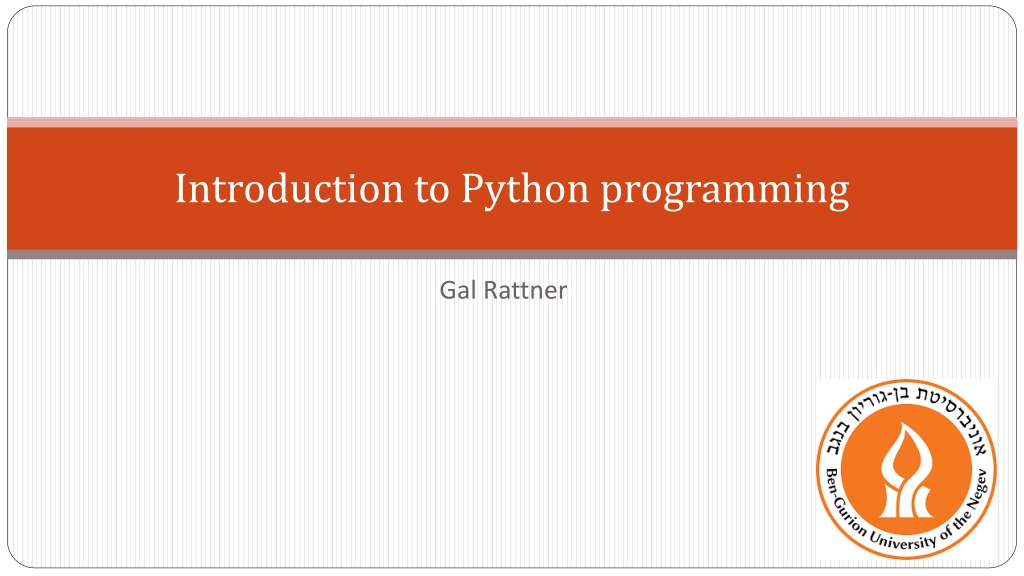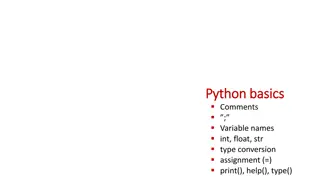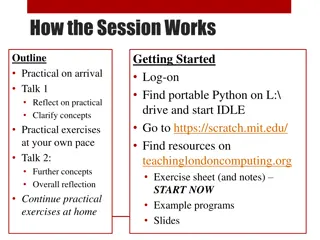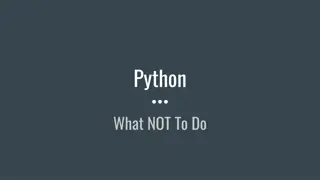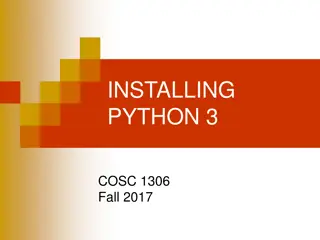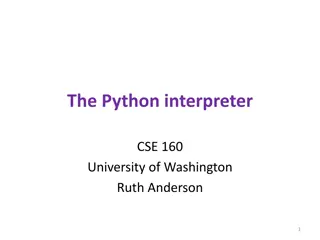A Comprehensive Overview of Python Programming
Python is a dynamic programming language that has gained immense popularity since its creation in 1991. This article covers topics such as the basics of Python, installation methods including Conda and PyCharm, usage of virtual environments, interpreters, packages like NumPy for mathematics, and syntax and functions with examples. It also discusses the two main versions of Python - 2.x and 3.x, highlighting the impending deprecation of Python 2.x in 2020.
Download Presentation

Please find below an Image/Link to download the presentation.
The content on the website is provided AS IS for your information and personal use only. It may not be sold, licensed, or shared on other websites without obtaining consent from the author. Download presentation by click this link. If you encounter any issues during the download, it is possible that the publisher has removed the file from their server.
E N D
Presentation Transcript
Introduction to Python programming Gal Rattner
Outlines What is python? Installation Conda Virtual environments & Interpreters Packages Syntax Functions Examples Links
What is python? Python is a dynamic (compiled at runtime) programming language, gaining huge popularity in the recent years Created in 1991 by Guido van Rossum It is open source packages are developed and released by programmers frequently There are two main versions to python: Python 2.x (late is 2.7) will be deprecated by 2020 Python 3.x (3.5/3.6/3.7) - mainly used Easy to learn mainly used for server programming, mathematics (replacing matlab), ML etc.
Installation Installation can be done in few ways: Python.org Anaconda3 managing installation of packages Pycharm JetBains Integrated Development Environment (IDE) for python We will install Conda and open Virtual environment Then we will install pycharm and define the environment as the project interpreter
Installation Installing Anaconda3 https://conda.io/docs/user-guide/install/windows.html#install-win-silent Pay attention that you install with the proper 3.x python version Using CMD prompt: The environments can be switched using activate <name> , deactivate <name> The * signify which env is now active
Installation Installing Pycharm Pycharm is one of the common IDEs (like MS Visual Studio for example) It is very comfortable and adjusted for remote connection and ML development Installation link: https://www.jetbrains.com/help/pycharm/install-and-set-up-pycharm.html Make sure to install the full version and not community edition (CE) for remote control ability.
Installation Open a new project and select the interpreter to be the conda virtual env you created. File settings project interpreter or in:
Python packages The basic Python language is very thin and shallow Extensions are added manually to each project as import <package> command Import should be used at the top of each python script file Some of the common packages numpy dealing with numbers and mathematics pickle save/load files os - operations on files (move/remove/create) time - times calculation tensorflow/torch ML packages *You can import a class/subpackage from a package, or rename an imported package
Python packages One of the most important packages for research work is numpy numpy has many Matlab-like functions and operators np.ones(100,10) np.squeeze() np.linspace() Etc. Use shortcut: import numpy as np All mathematics and vector operations should be done ONLY using np, for efficiency and preciseness Python math operations often include substantial errors
Python syntax Python data structures list the basic array structure in python, bound with [], can contain more than one data types [1, 2, 4, stam_string , 8, 16] np.array -- the numpy array type, used for vector/matrix math dictionary complex data structure that stores keys and their values { name : gal , age : 29, occupation : researcher } Syntax Indentation !!! Data copying make sure to use copy package to deep copy non scalar data objects Make sure not to use saved words as variables names (in, list, len, etc.) dot dot colon :
Python tips OOP define classes and call them to create objects init() functions Properties (@propery) private functions for effective and easy coding Use vectorization of the calculation (instead of for loops) reduces runtime by 1-2 orders Use global variables to use common data between functions Use pycharm debug mode all the time!
Links Python tutorials: https://www.w3schools.com/python/python_getstarted.asp https://www.learnpython.org/ Conda: https://conda.io/docs/user-guide/getting-started.html Pycharm: https://www.jetbrains.com/pycharm/documentation/ Linux tutorial (for server work): https://www.tutorialspoint.com/unix/ Michael Nielsen ML book & examples: http://neuralnetworksanddeeplearning.com/chap1.html
